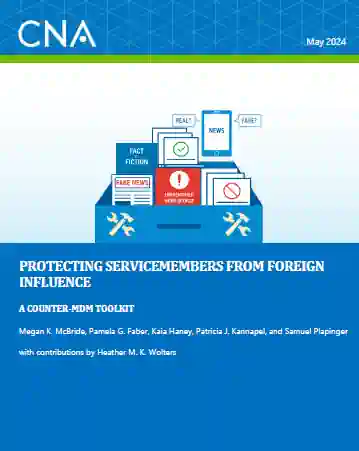Executive Summary
Recognizing the significant and growing threat to servicemembers from mis-/dis-/mal-information (MDM), the Department of Defense (DOD) has recently published policy and doctrine on social media use and the challenges posed by MDM. However, combating MDM is complex and requires a substantial and coordinated response.
A comprehensive human-centric approach to countering MDM (versus a technology-centric approach such as using AI to identify MDM) is one that recognizes the need to protect against our psychological and social vulnerabilities to MDM. In other words, it is necessary to acknowledge—and identify, design, and implement—counter-MDM solutions that address both the psychological vulnerabilities that make us receptive to MDM (e.g., our tendency to accept at face value content that looks official), and the social structures that make organizations vulnerable to the spread of MDM (e.g., our tendency to believe content from authoritative figures in hierarchical organizations). This work focuses on the former, but work on the latter is equally important.
MDM exploits normal psychological mechanisms that help people to function in their daily lives (for more, see our earlier work, The Psychology of (Dis)information). Further, the availability of MDM is constant due to the 24-hour “breaking” news cycle and the easy accessibility of cultivated content on social media platforms. In the 1960s, the primary MDM threat to servicemembers was limited to prisoners of war, so the US government mainly needed to provide tools and support to those affected persons. However, under the current threat, the US government needs to provide this training to every servicemember with a smartphone.
To counter MDM on a large scale within a distributed population—one that is constant being exposed to MDM—this research examined four evidence-based interventions:
- Inoculation: The practice of exposing individuals to persuasive messages containing weakened arguments that threaten an attitude or belief in order to “inoculate” them against stronger persuasive messages and attacks on this attitude or belief in the future.
- Debunking: The use of a concise correction to MDM that demonstrates that the prior message or messaging campaign was inaccurate.
- Fact-checking: A journalistic practice designed to reject clearly false claims with empirical evidence from neutral or unimpeachable sources.
- Media literacy: An individual’s ability to critically assess a piece of content. It includes the skills required to evaluate a piece of content as well as an understanding of the structures that produced that content.
A full review of the literature on these interventions—including a brief history and definition of each technique, a description of how they work, and a summary of the state of research on each technique—is available in the companion to this report: Evidence-Based Techniques for Countering Mis-/Dis-/Mal-information: A Primer. In that review, we summarized the literature that used the term debunking separately from the literature that used the term fact-checking. However, there is considerable overlap in the best practices, advantages, and disadvantages of these two techniques. Because this document is written for practitioners, we have combined debunking and fact-checking in our analysis and recommendations.
The primary objective of this report is to provide DOD with practical recommendations for how to use counter-MDM interventions to mitigate the threat. We first provide an assessment of how appropriate each intervention is to a military context, and then we provide DOD with recommendations for using these techniques, including methods (virtual or in person), timing for refresher training, and best practices. We also provide a list of available tools and our assessment of their adaptability for the military.
Appropriateness for the military
To evaluate the appropriateness of the interventions for the military, we considered five factors: the population studied, the structure of the intervention (e.g., scalability, length of time required for training, and neutrality of the content), the longevity of the effects, whether the intervention is preventative or reactive, and the flexibility of the intervention to function in both a steady-state and a crisis environment.
- We found that technique-based inoculation interventions are appropriate for the military, but issue-based inoculation interventions should be carefully considered to make sure that their content is nonpartisan.
- Debunking and fact-checking will not build counter-MDM skills on their own. However, corrections of inaccurate information do work and can create a healthier media ecosystem. Thus, it is important for DOD to engage in debunking and fact-checking when appropriate.
- Media literacy training is appropriate for the military because it can be prophylactic and skill-building. In addition, this training can be designed to be nonpartisan and neutral.
Recommended course of action and best practices
Our analysis indicates that each intervention has clear advantages and disadvantages. By combining them, DOD can create a scalable and durable training program that provides all servicemembers with a baseline level of knowledge (i.e., protection) and includes a mechanism for responding to an MDM campaign or crisis. Specifically, we recommend the following actions:
- DOD should identify and deploy an already-existing media literacy program.
- DOD should work with academic experts to adapt an already-existing inoculation intervention.
- DOD communications personnel (i.e., those who are engaged in public-facing communication and those who are engaged in communicating to the force itself) should engage in debunking and fact-checking when appropriate.
We also provide guidance to inform decision-making on when to use a specific type of intervention, language for how to describe trainings and interventions to those who will receive them, and tips for how to design the interventions (e.g., how to build a fact-check). These best practices are designed for policy-makers, leaders, public health officials, and public affairs officers and can help DOD identify, design, and implement counter-MDM training.
Download reportDISTRIBUTION STATEMENT A. Approved for public release: distribution unlimited.
Details
- Pages: 38
- Document Number: DRM-2023-U-035083-Final
- Publication Date: 5/23/2024
